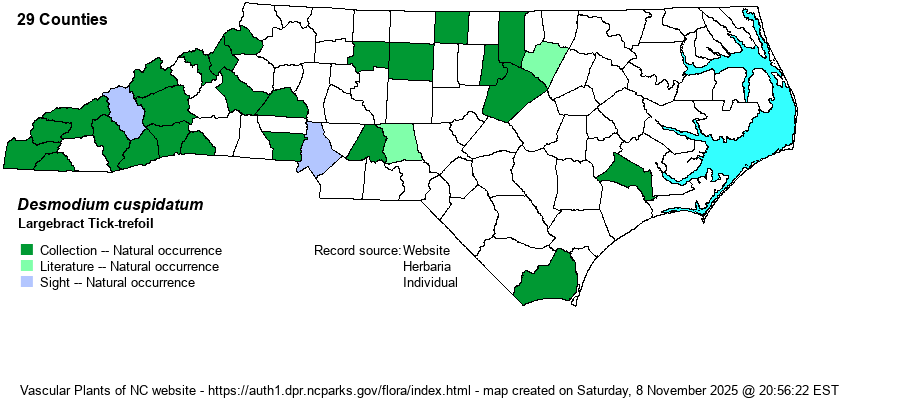| Author | (Muhlenberg ex Willdenow) de Candolle | |
| Distribution | Scattered over the southern and central Mountains, and widely scattered in the western and northern Piedmont. Disjunct to the eastern Coastal Plain (Jones and Brunswick Counties). Probably absent from the southeastern Piedmont and nearly all of the Coastal Plain.
This is primarily a Midwestern species, quite numerous from southern WI south to AR, but ranges east to NH and peninsular FL. However, it is very scattered in most Eastern states. | |
| Abundance | Rare to uncommon in the central and southern Mountains; very rare to rare in the western and northern Piedmont; extremely rare in the lower Coastal Plain. This is a Watch List species. | |
| Habitat | This is one of the few Desmodium species that shows an affinity for circumneutral soil. It favors mesic to somewhat rich soil, and is found in Basic Mesic Forest, Rich Cove Forest, and probably Basic Oak-Hickory Forest. As with most members of the genus, it is often found in wooded openings, edges of rich forests, and other areas of partial sun on high pH soil. The habitats listed in Weakley (2018) -- "Fields, woodland borders, disturbed areas" -- are incorrect and are seemingly the standard language for any Desmodium species. | |
| Phenology | Blooms from June to August, and fruits from August to October. | |
| Identification | This is a fairly tall species of Desmodium, often to 3 feet tall. It is notably smooth overall, with quite large leaves (3 leaflets) for the genus. The terminal leaflet is almost rhombic to diamond-shaped, with a long and tapering, acute tip, and about 3.5-4 inches long. The lateral leaflets are smaller and more ovate in shape, but with acute tips. At the end of the stem is a fairly open panicle of bright rose-colored flowers, each large for a Desmodium, about 1/2-inch long. The pods have triangular (angular) shapes to each segment in the pod, rather than rounded. No other species in the genus really looks like it, but as it is a rather rare species, few biologists are familiar with it, and thus upon seeing it likely will need to key it out. Persons familiar with it, however, can identify it by its quite large and strongly tapered terminal leaflet on a glabrous and rather robust plant. | |
| Taxonomic Comments | Weakley (2018) indicates that the nominate variety -- D. cuspidatum var. cuspidatum -- is the one found in NC.
| |
| Other Common Name(s) | Surprisingly none | |
| State Rank | S2? [S2S3] | |
| Global Rank | G5 | |
| State Status | W7 | |
| US Status | | |
| USACE-agcp | | |
| USACE-emp | | |

